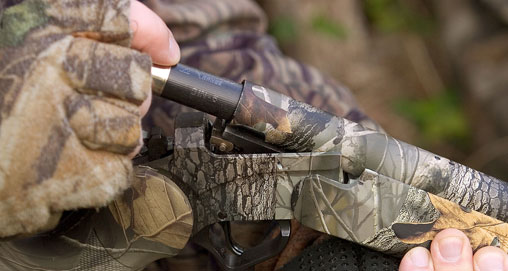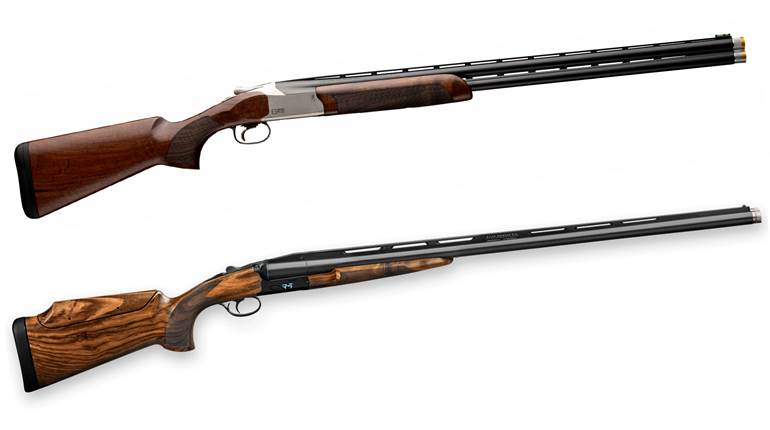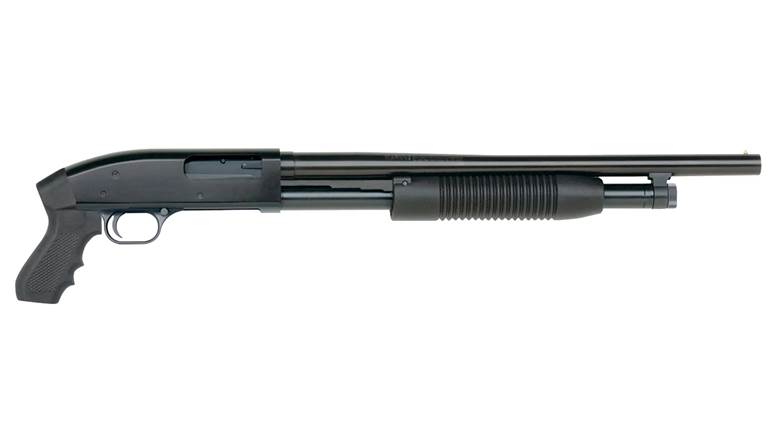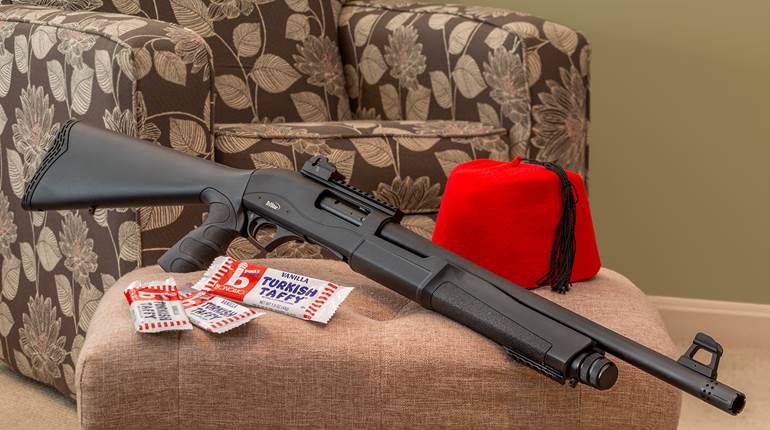
The moment of truth has arrived. It may have come in a hurry, with a lovelorn and lonely 2-year-old longbeard running to the call in kamikaze fashion. More frequently, however, the time to conclude affairs comes after a lengthy interchange that draws on reserves of patience and persistence. Whatever the case, when you squeeze the trigger on a wild turkey, loosing a load that can do the job is critical.
In addition to often being a one-man sport, turkey hunting is almost always a one-shot deal. A missed shot (or even worse, a crippling one with the bird escaping only to die later) means inner misery, haunting second thoughts and endless “what if” scenarios coursing through your mind.
All of these considerations place a high premium on having a shotgun/choke/shotshell combination that will do the job since turkeys aren’t easy to kill. When I first began to hunt turkeys nearly three decades ago, what might be termed as the sport’s modern era was still in its early years. Turkey guns, special turkey loads, after-market chokes and all of today’s special tools of the turkey hunter’s trade were virtually nonexistent. Until well into the 1980s my standard turkey shotshell for a trusted Fox Sterlingworth 12 gauge was a 2 3/4-inch high brass shell with one barrel holding No. 4 shot and the other No. 6 shot. These loads did their job reasonably well while accounting for a bunch of old, sharp-spurred thumpers, but on one troubling occasion, a crippled bird escaped. That experience still haunts me, and on two other hunts I located hard-hit turkeys only after lengthy searches.
With today’s loads, so long as the hunter knows his gun’s capabilities and selects a good choke/shell combo, such developments are rare. Most of the major ammunition manufacturers offer shotshells specifically designated as “turkey loads.” After some pleasant “homework” patterning, a hunter should be set for serious business in the greening-up woods of spring.
What you want is a high-velocity load that offers excellent pattern density. A turkey takes a lot of killing, and while a single pellet in the right place (brain or vertebrae) can do the job, you need far more than that. Ideally, a turkey gun should consistently place multiple pellets in the kill areas at the maximum suitable distance (40 yards is optimal for most hunters). Anything less than half a dozen pellets in the head and neck is unacceptable, and an average of a dozen or more is preferable.
A hunter should also pay careful attention to overall pattern density and not just the kill zone. With today’s turkey chokes, a hunter should place around 90 percent of the pellets inside a 30-inch circle at 40 yards. Of course, there’s a downside to such exceptionally tight patterns. Shooting at a turkey more closely resembles rifle shooting than wingshooting. A hunter really has to bear down with the cheek solidly on the stock (just remember the “wood” of your head to the wood of the stock) and use the sights on the shotgun. The vast majority of complete misses with turkey loads come from “operator error” with the hunter failing to get his or her head down. The fact that the barrels on most turkey guns are quite short increases the likelihood of this mistake—an error that can be mentally devastating after working so hard to get a bird close.
In truth though, with today’s loads and due recognition of their performance capabilities, there’s no reason to miss or have a hit that doesn’t kill cleanly and quickly. Turkey loads will do the job, and when something goes amiss, you can almost bet that the fault lies with the hunter, not the shotshell. That’s heartening news, because it means the turkey hunter who prepares properly and has an intimate understanding of the capabilities of his gun and chosen load has removed the element of chance from that aspect of the hunt. A quarter of a century ago, you couldn’t say that about the shotshells available to the turkey hunter.
This should not suggest, however, that development of turkey loads has leveled off on a plateau with no recent breakthroughs. Such is definitely not the case. Ammunition manufacturers continue to develop better loads for turkey hunting.
A few years back, for example, duplex loads, combining two shot sizes, appeared on the market. Then extensive testing by Winchester led to the introduction of its hard-hitting Supreme high-velocity shells. For a few years, that was the sport’s most popular shell, and justifiably so as is evidenced by consistently outstanding performance at the National Wild Turkey Federation’s World Still Target Championships.
Perhaps the most notable breakthrough of all came when Remington began offering Hevi-Shot loads (a non-toxic heavier than lead pellet).
Today, many shotshell manufacturers (ENVIRON-Metal, Federal, Remington, Winchester) produce hard-hitting non-toxic loads for turkey hunting that produce 25 percent greater downrange impact than lead loads, and exemplary pattern tightness. The loads are pricey, but unlike other shotgunning sports, turkey hunting involves little shooting outside the patterning process. Of course, with today’s chokes, a good lead load can also do the trick.
Further breakthroughs in shotshells designed specifically for turkeys probably await us in the future. But, already, turkey loads, like populations of the grand bird they are used to hunt, have come a long way in a relatively short time.
A Breakdown On Turkey Loads
Today’s turkey hunter has the luxury of a great many choices when it comes to shotshells. In the final analysis though, you want a load that suits your gun, your style of hunting and one in which you have confidence. Patient, thorough patterning will determine that load, and here is a selection of what is currently available as you test and pattern while working toward your final choice.
10 Gauge High-Density Loads
- Federal: 3 1/2" Mag-Shok HEAVYWEIGHT Turkey in Nos. 6, 7.
- Remington: 3 1/2” Wingmaster HD in Nos. 2, 4.
10 Gauge Lead Loads
- Federal: 3 1/2" Mag-Shok High-Velocity Lead in Nos. 4, 5, 6.
- Remington: 3 1/2" Premier Magnum Turkey in Nos. 4.
- Winchester: 3 1/2" Supreme Double-X Magnum in Nos. 4, 5.
12 Gauge High-Density Loads
- Federal: 3 and 3 1/2" Mag-Shok HEAVYWEIGHT Turkey in Nos. 5, 6, 7.
- Kent: 3” Tungsten Matrix High-Performance Turkey in No. 5.
- Remington: 2 3/4, 3 and 3 1/2” Wingmaster HD in Nos. 2, 4, 6.
- Winchester: 2 3/4, 3 and 3 1/2" Xtended Range HD in Nos. 4, 5. 6.
12 Gauge Lead Loads
- Federal: 2 3/4, 3 and 3 1/2" copper-plated lead in Nos. 4, 5, 6.
- Fiocchi: 2 3/4, 3 and 3 1/2” nickel-plated lead in Nos. 5, 6; 3" nickel-plated lead in Nos. 4, 5, 6
- Kent: 2 3/4, 3 and 3 1/2" Ultimate Turkey in Nos. 4, 5, 6.
- Remington: 2 3/4, 3 and 3 1/2" Premier Magnum Copper-Plated Lead in Nos. 4, 5, 6.
- Winchester: 2 3/4 and 3” Super-X copper-plated lead in Nos. 4, 5, 6.
20 Gauge High-Density Loads
- Federal: 3 Mag-Shok HEAVYWEIGHT Turkey in Nos. 6, 7.
- Remington: 2 3/4 and 3” Wingmaster HD in Nos. 4,6.
- Winchester: 3” Extended Range HD in No. 5.
20 Gauge Lead Loads
- Federal: 3" Mag-Shok High-Velocity Lead in Nos. 4, 5, 6.
- Kent: 3" lead in Nos. 4, 5, 6
- Remington: 3" Premier Magnum Copper-Plated Lead in No. 6.
- Winchester: 3" Supreme copper-plated lead in Nos. 4, 5.





































